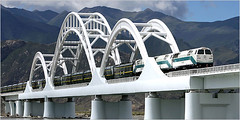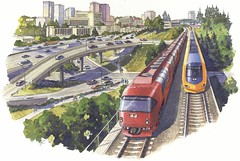The future of railroads is not in the U.S.

Agence France-Presse — Getty Images. The year-old rail service between Beijing and Lhasa, the capital of Tibet, is one of China’s ventures in rail technology, an industry that is expanding around the world.
From "Eastside rail: We just don't get it," in the Seattle Times, a commentary by Alfred Runte, director of special projects for All Aboard Washington, a rail-advocacy organization, and the author of Allies of the Earth: Railroads and the Soul of Preservation:
... Ask Europe and even China. Railroads are the way to the future. Nor is the problem just global warming. Annually, urban sprawl costs the United States up to 3 million acres of open space. Highways encourage all those losses. At that rate, an area the size of California will be gone — paved over — in less than 40 years.
Still, our elected officials — now including those at the Port of Seattle — tell us how wonderful a bicycle trail can be. "Someday" the Eastside rail line will be needed. That someday just isn't now. Paraphrasing a popular movie, "The American President," I used to think our politicians just don't get it. Finally, the historian in me understands. The deeper problem is that no American gets it, having lost all sense of what railroads do.
It started with the big lie of American culture: Railroads are out of date. Consider that while Europe and Japan launched high-speed rail service in the 1960s, we spent the decade tearing our railroads up. Why? Because the highway lobby convinced Congress to ignore our railroads, while paving companies, oil companies and vehicle manufacturers became the big campaign contributors.
Now the irony cuts like a knife. The 1960s also launched American environmentalism — when young activists like Al Gore got their start. However, in his documentary, "An Inconvenient Truth," railroads are out of sight. Between speeches, we find him lamenting global warming in an airplane — or a chauffeured limousine.

Image of Eastside railroad line, Seattle, from All Aboard Washington
Labels: energy, environment, railroads, sutainable land use and resource planning, transportation planning



0 Comments:
Post a Comment
<< Home